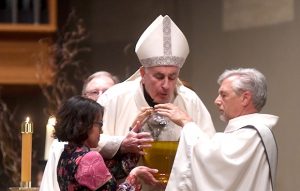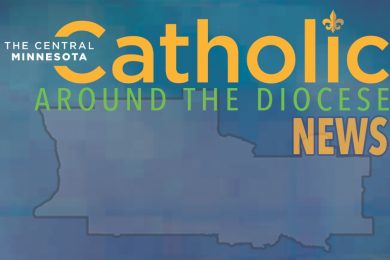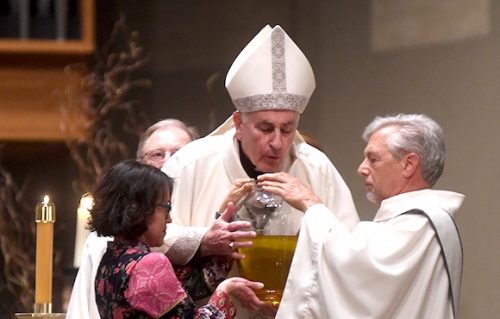Think for a moment about breathing. We are all doing it, and we do it all the time — awake or asleep, young or old, busy or at rest, without very often thinking much about it. Even with our sophisticated medical technology and imaging, we still spontaneously associate breath with life — and this is an important hint into the Holy Spirit.

At every Mass, we encounter the peace that Jesus promises the apostles in the Upper Room. The gift of Jesus at the Last Supper is not only the Eucharist, but what it establishes for us, that gift of peace with God: “Peace I leave you, my peace I give you.”
These were among the last words Jesus spoke before his death. In a rich combination of phrases, the Gospels tell us that the next day, from the cross, Jesus commended his spirit into the hands of his Father (Luke 23:46); “breathed his last” (Mark 15:37); and gave up his spirit (Matthew 27:50). John more explicitly says Jesus “handed over the spirit” (John 19:30).
On the third day, peace is also the first word the breath of the Risen Christ speaks to those same apostles, gathered in fear on Easter night. John records that vivid memory of his words: “’Peace be with you; as the Father has sent Me, so I send you.’ Then he breathed on them and said, ‘Receive the Holy Spirit.’”
Jesus breathed on them. This is the very breath of God, the Lord and Giver of Life. This is the same breath that hovered over the waters at creation, the same breath that the Creator had first given to Adam, as Genesis tells it; the same breath that gave voice to Christ’s words in his teaching; the same breath that was spent to the end on the cross, bringing peace and reconciliation with God.
Rather than a breath, artists more often depict the Spirit as a dove, from the Gospel accounts of Jesus’ baptism. Doves are certainly easier to portray artistically than the act of breathing. Yet even that appearance of the Spirit in the form of a dove is linked to this gift of peace and life: The dove sent forth from the ark and returning to Noah with an olive branch (Genesis 8:6-12) reveals that the work of cleansing the world of evil had been accomplished and a new land was appearing so they could begin a new life in a changed creation, at peace with God.

Doves aside, the link between the Holy Spirit and breathing is rooted in the Hebrew term “ruah” — breath or wind. It appears already in the first verses of Genesis and constantly throughout the Bible. Its rich and multifaceted meanings are complex; “ruah” is connected with the breath of life, the wind that manifests the Creator’s activity in the world, the invisible but real spirit that is present in living things but transcends simple physical place and time.
As Psalm 104 reminds us, God does not breathe as we do, to stay alive, but the living God gives being and life to all that is: “Send forth your spirit and they are created, and you renew the face of the earth.” Yet even before time began along with creation, God has been sending forth the Spirit from all eternity — not by physical breathing, of course, as we need to do, but the constant, dynamic exchange of personal love between Father and Son — love so profound, so perfect, so intrinsically a gift of one Person to the other that the Spirit is Person as well: the Third Person of the Triune God.
On Easter night, the Spirit was given, gently, in a breath, to the Eleven. On Pentecost, the Spirit is revealed to the world, a strong mighty wind. Both are manifestations of the same “ruah,” the same breath of God. Tongues of fire also appear to ignite faith, hope and love in the world; but fire can only burn where there is oxygen, again suggesting the Spirit’s breath that keeps us alive.
[perfectpullquote align=”left” bordertop=”false” cite=”” link=”” color=”” class=”” size=”14″]”Come, Holy Spirit, enkindle in us the fire of your love. Send forth your Spirit, and they shall be created; and you shall renew the face of the earth.” [/perfectpullquote]We are consoled by knowing that God’s love in the Spirit is as close to us as our own breath. The Spirit is our Advocate, Jesus says, our helper. The Spirit is also the Church’s memory, reminding us of all that Jesus told us, and our guide, leading us to all truth. The Spirit inspired the Scriptures, gave human life and breath to Jesus in Mary’s womb, is at work in the sacraments “like the dewfall” to continue the healing work of Jesus’ earthly ministry, makes of us temples that house divine life in our human needs.
When we face difficult decisions; when there are chores to do or conversations we would rather not have; when we come upon temptations in our lives: in such moments it is good for us to stop and take a deep breath, not just to give ourselves time to think, but to give time for God to speak, for the Spirit to breathe in our lives as well.
From the cross on Good Friday, the dying Jesus said, “Father, into your hands I commend My Spirit.” From the day of Pentecost, and down the centuries into our lives, the risen Jesus says to us: “Into your hands I commend my Spirit” — the gifts of God empowering us to announce the Gospel by word and even more, by example, so all may understand. We breathe; and as we breathe, we can recall that moment of our own confirmation, as John did, when the risen Christ breathed on him, and gave the gift of peace with those words: “Receive the Holy Spirit.”
Father Tom Knoblach is pastor of Sacred Heart in Sauk Rapids and Annunciation in Mayhew Lake. He also serves as consultant for health care ethics for the Diocese of St. Cloud.






















